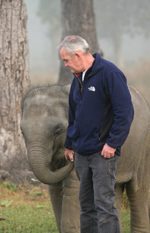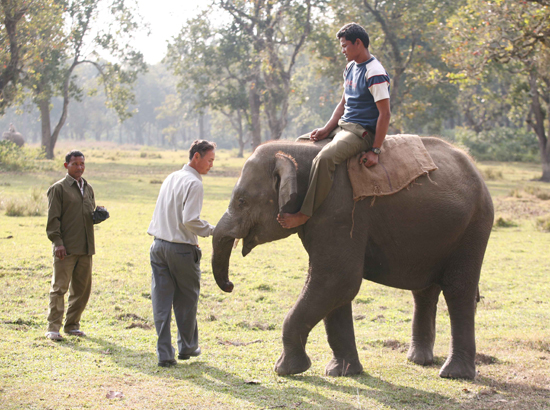 Australians are proving time and again that when it comes to animals, our scientists and trainers are world class. None more so than Dr Andrew McLean, a renowned horse trainer who now, in a remarkable twist of circumstance, has applied his training techniques to elephants. What’s even more astounding, however, is that Dr McLean is sharing his techniques in Nepal, a country where domesticated elephants have long been part of the culture. And as Anna Clemann reports, both elephant and trainer are responding to his techniques with enthusiasm and success.
Australians are proving time and again that when it comes to animals, our scientists and trainers are world class. None more so than Dr Andrew McLean, a renowned horse trainer who now, in a remarkable twist of circumstance, has applied his training techniques to elephants. What’s even more astounding, however, is that Dr McLean is sharing his techniques in Nepal, a country where domesticated elephants have long been part of the culture. And as Anna Clemann reports, both elephant and trainer are responding to his techniques with enthusiasm and success.
In Nepal, the management of domestic elephants began in 1903, with records showing 31 separate elephant camps with more than 300 elephants throughout Nepal’s lowlands.
Today in Nepal, elephants remain a vital part of the economy and culture. These majestic animals are used for tourism, rural activities, farming, for chasing away and cleaning up after poachers, and in religious and cultural ceremonies.
To accommodate these uses, the Nepalese train elephants to respond to more than 80 different commands. Training an elephant that can weigh as much as three-and-a-half tonnes, however, can be problematic if the subject doesn’t respond to the technique. The Nepalese methods, passed down through generations, have resulted in aggressive responses from elephants and even death to trainers. When the training was successful, it often took months to achieve even simple instructions.
Dr McLean, director of the Australian Equine Behaviour Centre, best-selling author and world-renowned horse trainer and ethologist, says that being guided by tradition, the Nepalese approach is unsystematic. It’s also at a disadvantage as it excludes modern, efficient principles of learning and reinforcement.
Ethology is the study of the behaviour of animals in relation to their normal environments, and Dr McLean is considered the world expert when it comes to ridden animals. And he’s in demand, conducting clinical ethology clinics in 12 countries and promoting ethical training clinics worldwide.
Despite the size difference, the jump from training horses to elephants is not a big one, but the impetus to do so is, and it came from a chance meeting. The Finnish World Wildlife Fund (WWF) and the World Society for the Protection of Animals (WSPA) recognised a need in Nepal and wanted to implement a step-by-step program for training elephants based on ‘learning theory’. They searched European zoos for an appropriate trainer but to no avail. Then the team discovered Dr McLean when he was conducting a clinic in Helsinki, and they knew they had found their trainer.
To prepare for working with elephants, Dr McLean first spent time at the Perth Zoo to familiarise himself with elephant behaviour and then with the trainers at Melbourne Zoo to learn how they work with elephants.
Dr McLean formulised a step-by-step program focusing on both teaching the elephants to become comfortable with people and positive reinforcement to train them. The training begins with food rewards and incorporates the use of vibrations on the elephants’ ear and neck to tell them to move forward, back and turn to one side or the other. Once this has been accomplished, trainers progress to using less food and increased pressure, which encourages the elephant to move quicker, with the reward then becoming the release of the pressure. The final step of the program is to habituate the elephant to a rider, and to pass the signals from a trainer on the ground to the person riding the elephant.
‘We started with positive reinforcement such as food rewards to train the elephants to respond to signals such as the pressure for go, stop and turn,’ says Dr McLean. ‘Once they [the elephants] began to understand, we fazed out the reinforcement and start using the pressure techniques more, and then gradually brought these down to a light touch with a voice command.’

By using the program, the Nepalese trainers were teaching elephants commands in a matter of days that had previously taken months to achieve using traditional methods. By the fourth day of training, the Nepalese trainers were riding the elephants and could direct them to move forward, backwards and turn.
In the teaching method, Dr McLean says, ‘I just refined what [the trainers] were already doing to make it more humane, and helped them to understand what actions would work and what actions might make [the elephants] react aggressively.’
The Nepalese responded with grace and enthusiasm. ‘They are the most wonderful, gentle, caring and happy people I have ever met and they were really willing to learn,’ says Dr McLean.
In fact, they were so eager to learn these techniques that they would practice at home that night after learning it with Dr McLean that day. ‘At one of the sessions we established how to teach an elephant to lie down. Some of the trainers practiced this in the evenings and then showed us the next day what they had achieved – this made us feel like they were happy to embrace what we were teaching them.’

Dr McLean says that working with elephants is not so different to working with horses; both are very intelligent animals that respond well to positive reinforcement and learn very quickly. There is, however, an anatomical difference he had to adjust to.
‘The trunk is like a loose cannon. Sometimes when I would be using pressure techniques, the elephant would use its trunk to hold my arm away,’ he says.
Dr McLean found, however, that the elephants were as caring and affectionate as the Nepalese people and discovered a connection with them.
‘Elephants touch more overtly affectionately [than horses]. You can feel it with horses, but elephants are more like dogs with their affection.’
The program has proven so successful that other countries such as Sri Lanka, Thailand and India are also interested in working with Dr McLean and the Finnish WWF and WSPA team. The Nepalese are also eager for the team to return.
Dr McLean is too. ‘It was very rewarding from a personal point of view and I felt quite an affinity with the elephants,’
No doubt the elephants felt it too.

All photographs: Courtesy of Dr Andrew McLean

